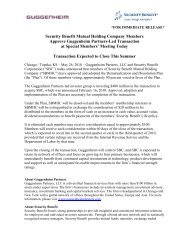THE CORE CONUNDRUM - Guggenheim Partners
THE CORE CONUNDRUM - Guggenheim Partners
THE CORE CONUNDRUM - Guggenheim Partners
You also want an ePaper? Increase the reach of your titles
YUMPU automatically turns print PDFs into web optimized ePapers that Google loves.
Assessing the Relative Value of the Barclays Agg<br />
Historical Yield per Unit of Duration<br />
4%<br />
3%<br />
0.3 %<br />
12/31/2012<br />
2%<br />
1%<br />
0%<br />
1976<br />
1979 1982 1985 1988 1991 1994 1997 2000 2003 2006 2009 2012<br />
Currently, the Barclays Agg is the least attractive it has ever been as measured by yield per unit<br />
of duration. Given the Fed’s recent pledge to keep rates low at least until specific unemployment<br />
or inflation targets are reached, the Index’s unattractiveness from an investment standpoint is<br />
likely to continue in the near term. Source: Barclays. Data as of 12/31/2012.<br />
Fiscal Policy Reconfiguring<br />
Composition of Barclays Agg<br />
Since its creation in 1986, the Barclays U.S.<br />
Aggregate Bond Index (the “Index” or the “Agg”)<br />
has become the most widely used proxy for the U.S.<br />
bond market with over $2 trillion in fixed-income<br />
assets managed to it. Inclusion in the Agg requires<br />
that securities be U.S. dollar-denominated,<br />
investment-grade rated, fixed-rate, taxable, and<br />
meet minimum par amounts outstanding. In 1986,<br />
the fixed-income landscape primarily consisted of<br />
U.S. Treasuries, agency bonds, agency MBS, and<br />
corporate bonds – all of which met these inclusion<br />
criteria. Therefore the Agg was a useful proxy for<br />
the universe of fixed-income assets. However,<br />
the fixed-income universe has evolved over the<br />
past twenty years with the growth of sectors<br />
such as asset-backed securities and municipals.<br />
Over the past five years, the composition of the<br />
Barclays Agg has been altered by the massive<br />
volume of Treasuries issued in response to the<br />
U.S. financial crisis.<br />
The sheer glut of Treasuries and their increasingly<br />
dominant representation in the Index is a trend<br />
unlikely to reverse anytime soon. The need<br />
to fund government shortfalls – present and<br />
future – is astonishing. The U.S. Treasury debt<br />
5 | <strong>THE</strong> <strong>CORE</strong> <strong>CONUNDRUM</strong> GUGGENHEIM PARTNERS














